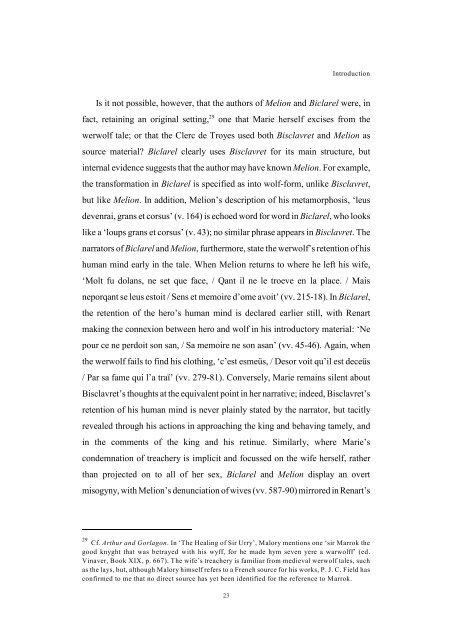Melion and Biclarel - University of Liverpool
Melion and Biclarel - University of Liverpool
Melion and Biclarel - University of Liverpool
Create successful ePaper yourself
Turn your PDF publications into a flip-book with our unique Google optimized e-Paper software.
Introduction<br />
Is it not possible, however, that the authors <strong>of</strong> <strong>Melion</strong> <strong>and</strong> <strong>Biclarel</strong> were, in<br />
29<br />
fact, retaining an original setting, one that Marie herself excises from the<br />
werwolf tale; or that the Clerc de Troyes used both Bisclavret <strong>and</strong> <strong>Melion</strong> as<br />
source material? <strong>Biclarel</strong> clearly uses Bisclavret for its main structure, but<br />
internal evidence suggests that the author may have known <strong>Melion</strong>. For example,<br />
the transformation in <strong>Biclarel</strong> is specified as into wolf-form, unlike Bisclavret,<br />
but like <strong>Melion</strong>. In addition, <strong>Melion</strong>’s description <strong>of</strong> his metamorphosis, ‘leus<br />
devenrai, grans et corsus’ (v. 164) is echoed word for word in <strong>Biclarel</strong>, who looks<br />
like a ‘loups grans et corsus’ (v. 43); no similar phrase appears in Bisclavret. The<br />
narrators <strong>of</strong> <strong>Biclarel</strong> <strong>and</strong> <strong>Melion</strong>, furthermore, state the werwolf’s retention <strong>of</strong> his<br />
human mind early in the tale. When <strong>Melion</strong> returns to where he left his wife,<br />
‘Molt fu dolans, ne set que face, / Qant il ne le troeve en la place. / Mais<br />
neporqant se leus estoit / Sens et memoire d’ome avoit’ (vv. 215-18). In <strong>Biclarel</strong>,<br />
the retention <strong>of</strong> the hero’s human mind is declared earlier still, with Renart<br />
making the connexion between hero <strong>and</strong> wolf in his introductory material: ‘Ne<br />
pour ce ne perdoit son san, / Sa memoire ne son asan’ (vv. 45-46). Again, when<br />
the werwolf fails to find his clothing, ‘c’est esmeüs, / Desor voit qu’il est deceüs<br />
/ Par sa fame qui l’a traï’ (vv. 279-81). Conversely, Marie remains silent about<br />
Bisclavret’s thoughts at the equivalent point in her narrative; indeed, Bisclavret’s<br />
retention <strong>of</strong> his human mind is never plainly stated by the narrator, but tacitly<br />
revealed through his actions in approaching the king <strong>and</strong> behaving tamely, <strong>and</strong><br />
in the comments <strong>of</strong> the king <strong>and</strong> his retinue. Similarly, where Marie’s<br />
condemnation <strong>of</strong> treachery is implicit <strong>and</strong> focussed on the wife herself, rather<br />
than projected on to all <strong>of</strong> her sex, <strong>Biclarel</strong> <strong>and</strong> <strong>Melion</strong> display an overt<br />
misogyny, with <strong>Melion</strong>’s denunciation <strong>of</strong> wives (vv. 587-90) mirrored in Renart’s<br />
29<br />
Cf. Arthur <strong>and</strong> Gorlagon. In ‘The Healing <strong>of</strong> Sir Urry’, Malory mentions one ‘sir Marrok the<br />
good knyght that was betrayed with his wyff, for he made hym seven yere a warwolff’ (ed.<br />
Vinaver, Book XIX, p. 667). The wife’s treachery is familiar from medieval werwolf tales, such<br />
as the lays, but, although Malory himself refers to a French source for his works, P. J. C. Field has<br />
confirmed to me that no direct source has yet been identified for the reference to Marrok.<br />
23
















